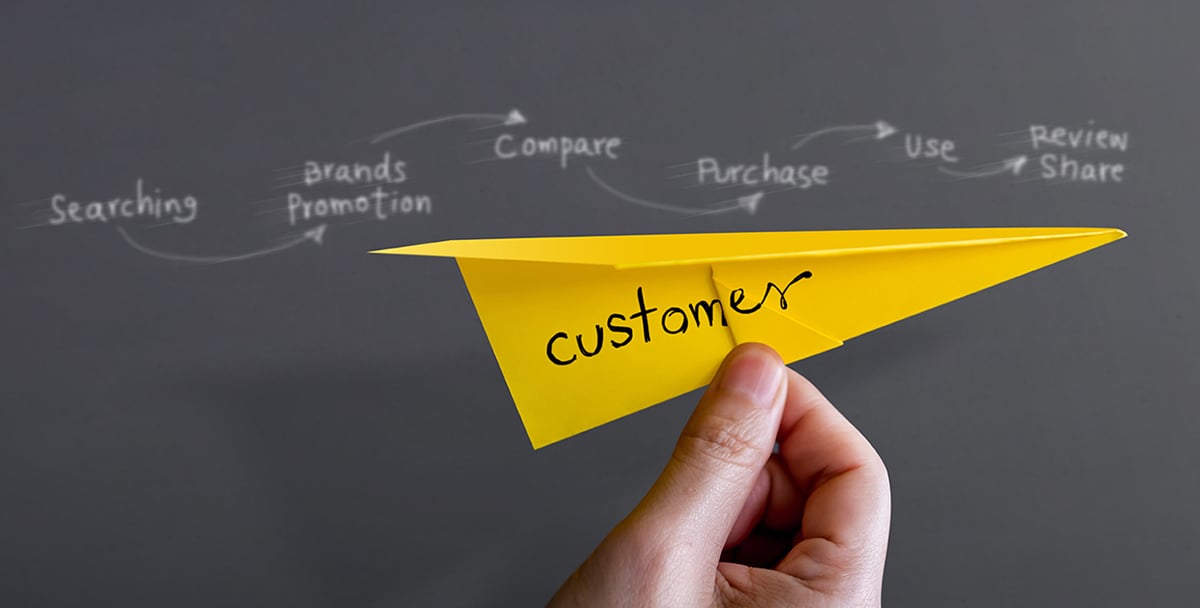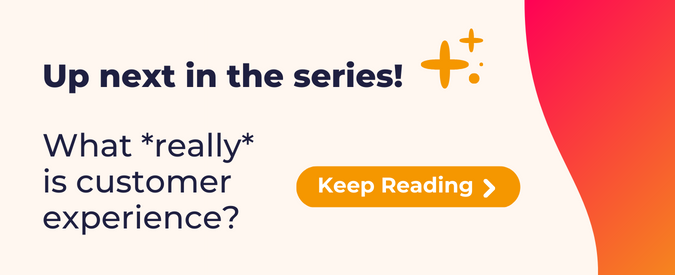The processes companies use to attract and retain customers are most commonly referred to as the buyer's journey and the customer journey.
These two very different efforts are commonly confused with one another. Marketers don't always understand the difference between the two or which one they need.

Most importantly, as marketers, we all need to understand better how these concepts fit together within a great customer experience.
The Difference Between the Buyer's Journey and the Customer's Journey
The significant differences between the buyer's journey and the customer journey are the timing and intended results.
A buyer's journey is the process a prospect goes through to become a customer, while a customer's journey is the process of nurturing existing customers to retain their business.
In the sales and marketing machines of modern companies, both are important for very different reasons. And each requires a separate, targeted strategy to make the most of your efforts.
Learn how both can be used (separately and together) to boost your bottom line.
- What is the buyer's journey?
- What is the customer's journey?
- Should you use one or use both?
- How do they fit together?
- What comes next?

What is the Buyer's Journey?
The buyer's journey is a well-known marketing and sales strategy used to convert prospects into customers. The process is broken down into the stages a buyer goes through to make a purchase.
The Three Stages of the Buyer's Journey
The best way to understand the stages of the buyer's journey is to think about them in the context of a specific purchase or pain point.
The Awareness Stage
The buyer's journey begins when the buyer starts to notice a problem or need. Something is happening that needs to be addressed, although they might not know precisely what the problem is yet.
Example: I'm not feeling so great. I wonder if I'm sick.
The Consideration Stage
Now that the buyer has a name for their problem or need, they can research the different solutions available for solving it.
Example: Oh! My symptoms are all pointing to the flu. I'm going to check out the additional testing and treatment options available.
The Decision Stage
The buyer is ready to make a purchase and is busy finalizing the details of their chosen solution.
Example: I'm going to see my primary care doctor for a flu test and medication because flu medicine is most effective when taken shortly after the onset of symptoms. The ER is too expensive and busy.
→ Dive Deeper Into the Buyer's Journey Here
Why is the buyer's journey important?
For the marketer, the buyer’s journey is all about the right content at the right time. Each stage comes with different questions and needs.
Your content, messaging, and experiences need to create paths that seamlessly flow from one stage to another to help nudge the buyer along their journey. Buyers need a guide (aka you) to aid their steps to a valuable solution.
Who is the buyer's journey for?
In short - the buyer’s journey is for anyone with a service or a product to sell.
While the process itself appears to be linear and simple, buyers are not. They will move between stages multiple times and may have complex motivations and needs that cannot be contained squarely in one stage. This is why they need a leader to inform, guide, and encourage.
What is the cost of not using one?
The cost of not using a buyer’s journey is massive.
Think about your staff’s lost time creating content that isn’t solving a problem. Or wasting your visitor’s time by leaving them to fend for themselves in finding the next step. Or worse - pushing visitors to your competitors’ websites for the information they are seeking.
Your content should be doing some heavy lifting here because according to Spotio, “50-90% of the journey is complete before a buyer interacts with a sales rep.”
This means most of the interactions your buyers have with your brand are indirect or passive through content and digital experiences, not a person. It’s much easier for a human to redirect a conversation to adapt to the buyer and where they are in their journey. But indirect and passive interactions with your brand require a deeper understanding and preparation of content based on their journey.
Long story short - use the buyer’s journey.
So how does it work?
The Buyer's Journey: In Content
Putting content together to tell the story of the buyer’s journey is not unlike putting together a puzzle. Pieces fit in exact spots to achieve the desired result.
Content is not one-size-fits-all for each stage. For example, consider a wide range of educational blogs exploring a topic from every angle in the awareness stage and product comparisons and case studies in the decision stage
One mistake to watch out for is not just zeroing in on awareness stage content production. You should intentionally spread out your content across all stages.
When you have consistent content for each stage that is also created for your company’s specific buyer’s personas you create a winning marketing strategy!
The Buyer's Journey: In Sales
While a sale is the end goal of the buyer’s journey, your sales team is not the star of the show.
Instead, they play a vital role behind the scenes in developing your buyer personas. No one understands what your buyers need to know before making a purchase better than your sales team.
Working with the sales team also helps ensure a smooth transition from marketing to sales that is consistent and thoughtful. Your sales team is the living, breathing tour guides who will add the one-to-one touches at the right time to continue the buyer's journey.
The Buyer's Journey: In Marketing
Remember that stat we mentioned above where a large part of the buyer’s journey is completed before sales interactions? This is where marketing plays a huge role. Be sure the foundation of your inbound marketing is solid before building your buyer’s journey.
This means you should understand your buyer personas, industry-standard practices, gaps, competitors, and the education that exists. Use this to fuel helpfulness, creativity, and intentionality in your marketing campaigns, content creation, and overall messaging and experience building.
These background steps will make sure that your marketing strategy and individual tactics set the stage for helping strangers become customers.
The Buyer's Journey: In Operations
Operations help you focus on content delivery and action-oriented processes. You can accomplish this by making sure each message or piece of content leads naturally to continued nurturing and/or a conversion point so the journey never pauses.
Remember: create content with an intention, not for the sake of it.
What does success look like?
The details of a successful buyer's journey strategy will look different for every company, but there will be some fundamental consistencies.
Each phase will have a range of different content types that answer your target buyer personas' questions without any voids or gaps.
Buyers should be able to flow frictionlessly from one stage into the next, making the process of becoming a customer smooth, simple, satisfying, and easy to navigate.
What is the Customer's Journey?

Unlike the buyer's journey, the customer journey isn't intended to make the buyer more educated and aware of problems or needs and potential solutions.
It's a process of strengthening and deepening their brand loyalty through targeted post-purchase touchpoints that delight by entertaining, enriching, and enhancing their experience as a customer of your brand.
When someone makes a purchase, they're not signing on as your customer for life, just for the moment.
The customer journey's goal is to make that moment as long as possible, leading to additional purchases and glowing recommendations to everyone they know.
Why is the customer journey important?
Once a purchase is completed or service is started, consider yourself along for a new journey: the customer journey. From this point on, your focus is delighting, exciting, and gratifying customers.
Your customers will expect to be treated like friends and not strangers from now on. They have invested time, information, and money with you, so they expect intention, warmth, and recall from you to continue to deepen the relationship.
Not only is it the right thing to do, but it’s also good for business! How? Well, understanding and planning your customer journey makes way for building loyalty, brand reputation, and referrals with happy customers.
Customers want to be appreciated, understood, and valued – and when your clients are happy, you can potentially generate spin-off sales from their network.
So what does that customer appreciation look like? Think entertaining, enriching, and enhancing their experience as a customer of your brand.Who is the customer journey for?
Just like the buyer's journey, the customer journey strategy is for every business. It doesn't matter if your focus is business to business, business to consumer, or even business to government.
Every company with a customer base that has the potential for generating repeat or referral business should be using a customer journey strategy to maximize the lifetime value of their most important asset– existing customers.
What is the cost of not using one?
The cost of not using a customer journey could be disastrous for your company because your competitors are certainly using it.
According to Deloitte, customer spending increases up to 140% following a positive experience. You want those customers to buy with you, not other companies, right?
Or how about this fact: per Salesforce, 80% of customers say their customer experience is a deciding factor in choosing one brand over another.
And here’s the kicker, “64% of customers are more likely to recommend a brand to others if it offers amazing experiences.”
So, if your customers will choose you and they’ll spend more and they’ll refer their friends and family, then how could you not invest in your customer journey?
So how does it work?
The Customer Journey: In Content
In the customer journey, content is more important than ever. Not only is the audience way more receptive to listening to your brand than they were before making a purchase, but they'll also expect more from you than the typical buyer's journey content.
Send them relevant content designed for pre-purchase audiences.
Use a wide array of content to target existing customers on social media, in person, via email, and beyond.
Make them laugh, make them think, help them use your product and service better, educate them, enrich their lives, and inspire them with your brand's values and actions.
However, you choose to establish loyalty, motivate word-of-mouth marketing using the customer journey, and fuel your efforts with authentic, valuable, and unique content created specifically for your customer personas.
Examples:
- Newsletters
- Product tips
- Tweets
- Merchandise
- Surveys
- Giveaways
- Appearances
- Sponsorships
The Customer Journey: In Sales
If you can trace a direct line from new sales to existing customers, reward them for it! Significant loyalty or promotion programs can go a long way to keep customers engaged, purchasing, or actively recruiting on your behalf.
Don't forget to solicit feedback from your current customers as you workshop new products or services that may be relevant to them in the future.
And when a repeat purchase comes along, be sure to differentiate existing customers from new ones.
These are old friends and should be treated better than someone whose email you don't have.
The Customer Journey: In Marketing
Connect and communicate where your customers are, on social media, through email, and at in-person events. Just remember you have a very different goal than you would with buyers. Think of your brand as more of a friend than a business.
A friend wanting to engage with and enrich the lives of your customers rather than sell to them.
The Customer Journey: In Operations
Even content for existing customers shouldn't be created just to be sent off into the void, hoping it impacts. Strategic, actionable steps should be built into everything you make, even for the customer's journey.
It won't look like the textbook conversion path from the buyer's journey, but you should still map out logical actions that lead your customers further down the rabbit hole with relevance.
What does success look like?
Your customer's journey strategy should begin by engaging customers as they make their initial purchase and continue to do so consistently, with the right types of content, on the right platforms, for your specific customer personas.
Aim for regular purchases, high net promoter scores, a steady increase in business from referrals, and brand loyalty longevity.
Successful customer journey efforts will be even more evident in your bank account than a successful buyer's journey strategy.
When to Use the Buyer's Journey vs. Customer Journey
Businesses should leverage both the buyer's journey and the customer journey in their content, sales, marketing, and operations strategies. For start-ups and those primarily focused on building their customer base, the buyer's journey should be the main focus.
Once you've got a solid base of customers you want to retain, shift some of that attention to the customer's journey to maximize your loyal fans' lifetime value and turn them into avid promoters of your brand.
Together They Make a Customer Experience
The customer experience encompasses the entirety of your strategy for potential, new, and existing customers. It begins with the buyer's journey meeting the customer wherever they are in the buying process and giving them all the information they need to convert into customers frictionlessly.
It ends when you deliver on your promise.
Think of the customer journey as beginning then, at the end of the buyer's journey. As the buyer converts to a customer, your marketing and sales efforts shouldn't stop; they should shift.

Within the customer journey, there should also be ongoing opportunities that help the customer identify additional pain points or needs. Doing so would begin the buyer's journey again, within the scope of a different product or service than their initial purchase.
Friends not rivals: what comes next?
When you put the buyer’s journey and the customer journey together, you create the customer experience. It starts with meeting the customer and giving them the information they need. It ends when you deliver on your promise.
Throughout their experience, you will have plenty of chances to help the customer identify additional pain points or needs, which can restart the buyer’s journey again through the scope of a different product or service than their initial purchase.
So, the natural next question is: what is customer experience? Don’t worry - we wouldn’t leave you hanging. Zoom out and see the bigger picture by reading our next blog, “What *really* is customer experience?”

.png?length=450&name=Blog%20Hero%20Images%20(1).png)



